A beginner’s guide to growing with hydroponics
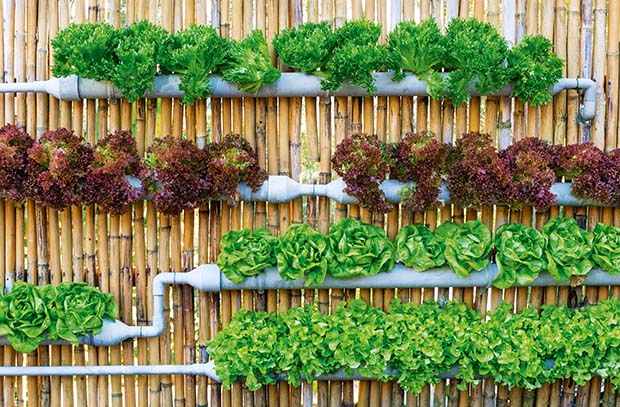
Growing veggies hydroponically is the ultimate way to maximise an indoor harvest. This soil-free gardening system is a satisfying way to reap home-grown goodness.
This story is an extract from In Your Backyard: Urban Harvest. Order your copy here
Words: Emma Rawson
WHAT ARE HYDROPONICS
Hydroponic plants grow in nutrient-rich oxygenated water, which is fed to the root system. Rather than soil, the plant’s root system is often supported by a coarse growing medium, such as vermiculite, Rockwool, clay pellets, perlite or peat moss. Water is oxygenated with a pump, oxygen stone or aerated through a drip system – the oxygen is vital in keeping plants alive and thriving.
THE BENEFITS OF HYDROPONICS
• Fast growing
• High yielding (tomato plants can yield 14kg of fruit each)
• Good for small spaces
• Extended winter growing season
• Water efficiency: hydroponic systems use less water than conventional gardens

Tomato seedlings in rockwool.
SYSTEMS AND SOLUTIONS
Nutrient Film Technique (NFT), Deep-water Culture (DWC) and Ebb and Flow (see bellow) are the most common systems and equipment for them is readily available from hydroponic and hardware stores and Trade Me. DWC is the most accessible for beginners; a low-cost DIY system that’s less prone to disease. While hobby hydroponic systems are taking off in the United States and Europe, fewer beginner kits are available in New Zealand (try Autopot from Easygrow.co.nz, Bubble Grow from hydromart.nz, Egmont Hydroponic CompleteKit from hardware stores, or look for hobby models on Trade Me). Nutrient water solutions can be bought from Trade Me and hydroponic stores, and Egmont hydroponic solutions are available at hardware stores, (Egmont solutions allow growers to adapt nutrient levels according to a plant’s needs).
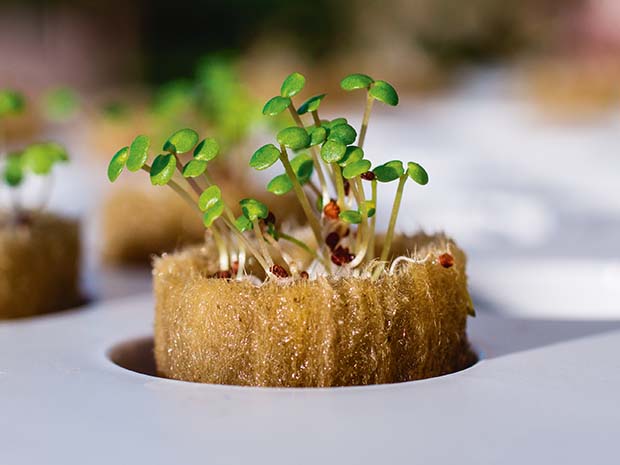
Suitable crops
• Fast-maturing crops such as rocket, kale, lettuce and spinach
• Herbs such as basil, parsley, oregano, coriander and mint
• Watercress is well-suitedto NFT or Ebb and Flow
• With good aeration andgrowing supports, tomatoes, chillies, aubergines and runner beans grow well in DWC
• Strawberries do well due to their shallow root systems and can be planted from runners
TYPES OF HYDROPONICS
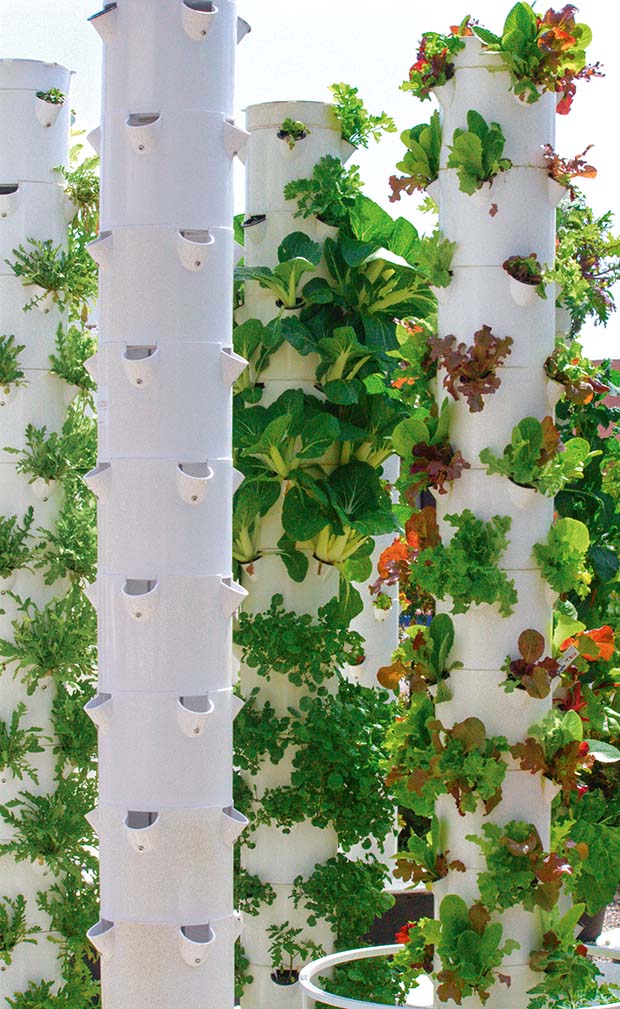
Aeroponics
Aeroponic systems spray suspended roots
with a fine mist of nutrients, which allows
for maximum oxygen exposure. Although complex and expensive, Aeroponics are proving promising for the future of urban vegetable production.
In California, several urban farms use a vertical tower system called Vertigro to grow large crops in a small space, with minimal water.
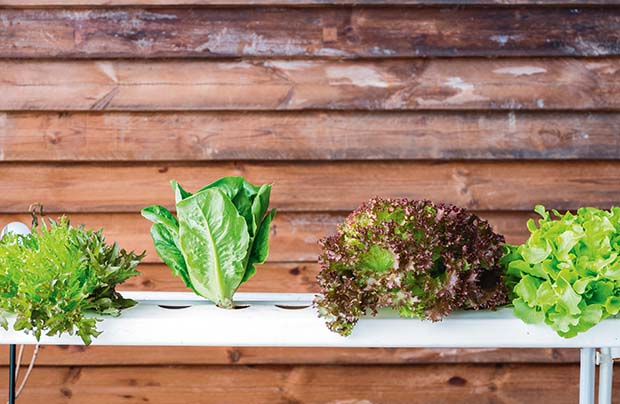
Nutrient Film Technique (NFT)
One of the oldest methods, NFT is popular among commercial growers.
It uses gravity-driven channels of water to create a continuous flow of nutrient-dense water over plant roots. Hobby systems can be built in an A-frame shape or on a tilt to create gravity pull. NFT systems need only a shallow amount of nutrient water (more like a thin film) as the root is only partially exposed to nutrients. This is a highly efficient method, but hobby systems are prone to malfunction should water stop flowing.
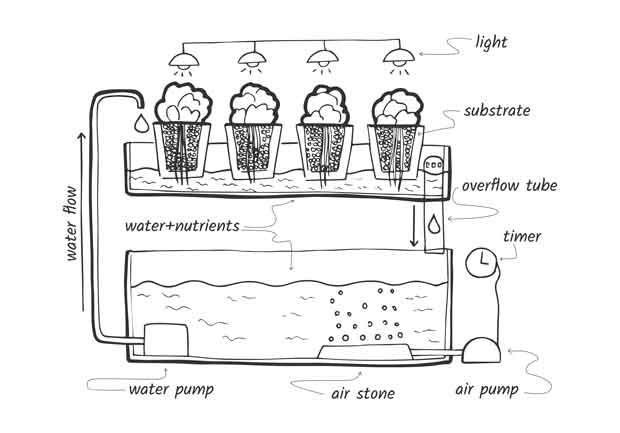
Ebb and Flow
This system works by flooding growing beds at intervals, then draining the water to expose roots to oxygen and release carbon dioxide. Ebb and Flow uses a submerged pump on a timer to temporarily flood the grow tray. This reliable system is best suited to the experienced hydroponics grower.
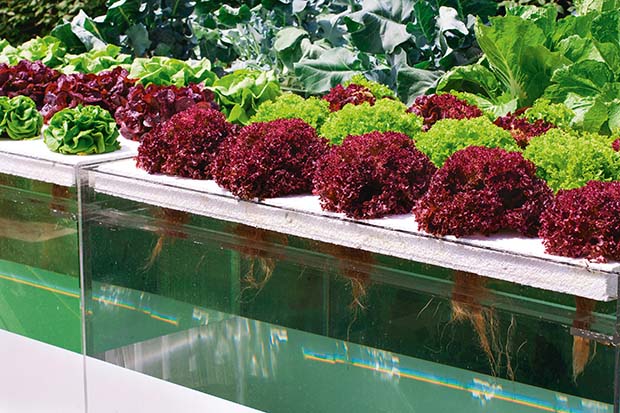
Deep-Water Culture (DWC)
Sometimes known as a reservoir system, DWC plant roots are attached to a growing medium in a net pot and suspended in a deep vessel of nutrient solution. A pump delivers oxygen to the water to prevent roots drowning. Plans for DWC systems are freely available at instructables.com and can be as easy as cutting holes into the lid
of a bucket or plastic storage tub. Be sure to use an opaque container to avoid light reaching the water and encouraging algal growth. For an affordable, ready-made option, try a Bubble Grow bucket system from hydromart.nz. Downsides to DWC are a power outage or air-pump failure, which will cause plants to die within hours; and only
a few plants can be grown at one time.
DWC Tips
• Maintain a temperature between 18-22°C
• Root systems can become large; don’t let them clog the water pump
• It’s possible to transplant a seedling or strawberry runner from soil straight into a net pod and growing media, although there is the risk of fungal infection. To transplant, simply shake soil from the roots, then leave roots to soak in a glass of water for 10 minutes.
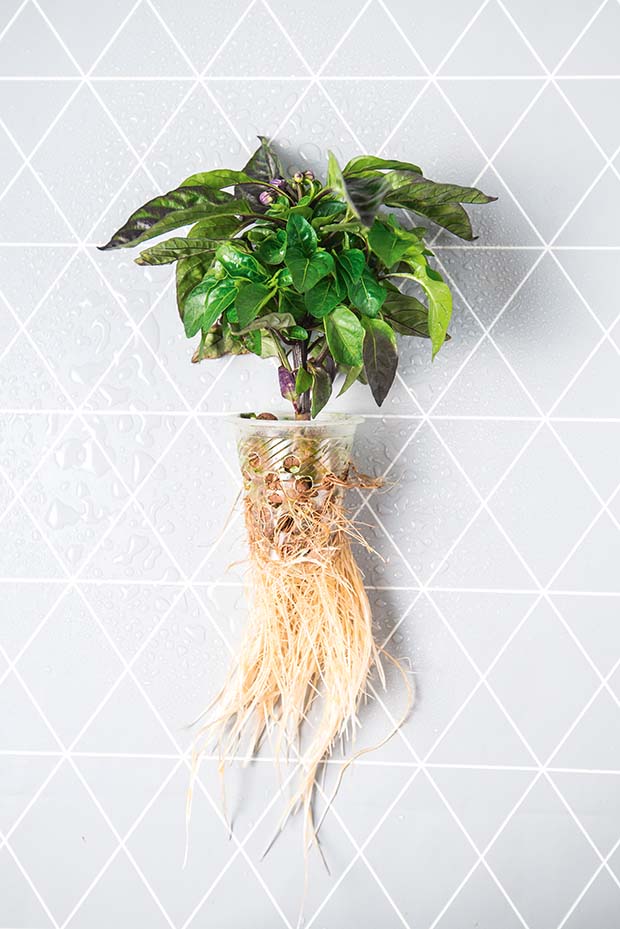
SEED STARTING FOR DWC
You’ll need
● Rockwool
● Propagation tray or a covered plastic pot
● Small amount of vermiculite
● Toothpick
● Paper towel
● Net pod
● Nutrient water
Rockwool is the easiest medium to start seeds for hydroponics; the keyis for it to be wet enough to encourage germination, but not too wet that it stifles oxygen. To germinate in Rockwool, cut into cubes and soak in water until saturated, then transfer to a sink for 15 minutes to allow some of the water to drain. Put the damp Rockwool in a propagation tray without drainage holes – a windowsill propagation tray is ideal – and use a wet toothpick to transfer seed to the wall of the cube. Cover seeds with a small amount of vermiculite, moisten with a water sprayer, then leave to germinate. Once the seed has sprouted and true leaves have formed, half fill a net pod with growing media (such as clay balls), place Rockwool in the pod and fill to the top with clay balls – the base of the plant should be above the surface.
Water-wise
• Tap water tends to be chlorinated, which is thought to inhibit plant growth. To de-chlorinate, leave water in a bucket for 24 hours to evaporate the chemical. To speed up the process, pump water with an air pump.
• Plants are sensitive to pH levels – test with
an electronic pH tester and adjust levels with solutions (available on Trade Me) or by adding baking soda to increase the alkaline content
or nitric acid to make water more acidic
Tip Organic-soil gardens break down with fungus and bacteria, but in a soil-less environment, fungus can cause roots to rot. Be careful Ato germinate seed in sterile conditions and not introduce organic material into the system.
HYDRO HISTORY

An artist’s impression of the Hanging Gardens of Babylon, one of the Seven Wonders of the Ancient World.
In 1929, William Frederick Gericke of the University of California, Berkeley, published the first scientific study of hydroponics as a form of soil-less agriculture, but there are examples of hydroculture gardens in ancient civilisations. Some historians believe the Hanging Gardens of Babylon relied on a chain-pull system that carried river water to the top to trickle down through the garden. In the 10th and 11th centuries, the Aztecs built chinampas,
a floating garden system in Lake Tenochtitlan, Mexico, to irrigate crops on rafts in the area’s marshy conditions.
OUT OF THIS WORLD
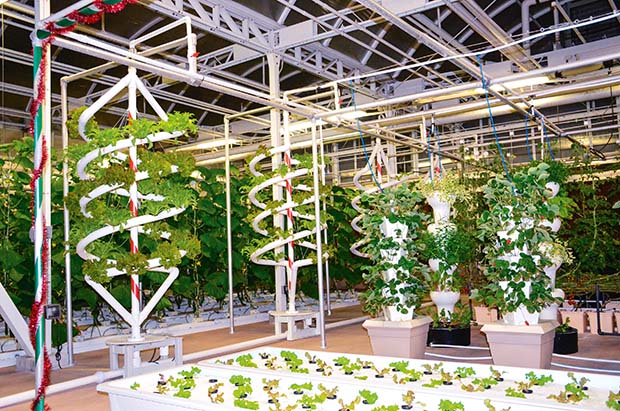
As NASA prepares for missions to Mars, it’s researching hydroponics as a means of food and oxygen production.
READ MORE
To study up on hydroponic techniques, read Beginner’s Guide to Hydroponics by James Sholto Douglas; and Hydroponics: Hydroponics Gardening Guide – From Beginner to Expert by Thomas Thatcher; and watch the MI Gardener and GrowAce YouTube channels.

This story is an extract from In Your Backyard: Urban Harvest, a special edition of NZ Life & Leisure, about growing food in small city spaces. It’s packed with advice such as how to start a productive veggie garden, the best crops, creating awesome soil, vertical growing, container gardening, hydroponics, espaliered trees and edible hedges. Order online at shop.thisnzlife.co.nz
MORE STORIES YOU MIGHT LIKE


